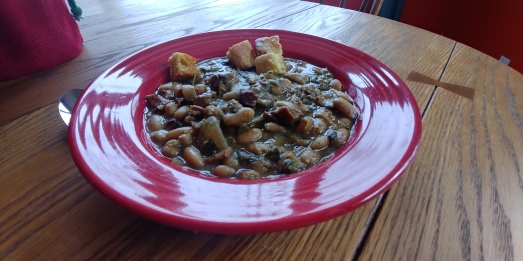For years I’ve enjoyed sometimes making a white chicken chili, just on the stovetop, with boneless, skinless chicken breast, onion, canned green chilis, and cannellini beans. Since I’ve been smoking meats in my old gas grill for the past year or so, I decided to switch that recipe up; here’s a smoked chicken chili made with those same canned white beans and accompanied by other fresh ingredients.
This sacrifices the unusual, uniform white color of a white chicken chili, for the darker tones one would expect to accompany chicken, onion, and peppers all wood-smoked for hours.

Smoked Chicken Chili with Cornbread Croutons
Here’s what you’ll need, first, for the smoker:
- 3 boneless, skinless chicken breasts
- 1 large, sweet onion, halved
- 3 poblano chili peppers, fresh, core, seeds removed
- 2-3 cloves fresh garlic

Boneless, skinless chicken breasts, poblano chilis, and sweet onion smoking on Hickory
Here are the remaining ingredients to prepare the chili:
- ~5 cups low-sodium soup stock (I used homemade turkey stock from Thanksgiving’s turkey carcass)
- 2-3 tablespoons vegetable oil
- 3 15-ounce cans of cannellini beans, drained
And flavor the chili with the following, to taste:
- salt
- ground black pepper
- Mexican oregano
- ground cumin
- ground cayenne pepper (optional)
- ground Ancho chili pepper (optional)
- garlic powder

Ingredients to flavor the chili

Chicken Chili prior to adding the Cannellini Beans
To prepare:
- First, I smoked the chicken breasts (lightly salt-brined overnight), halved onion, and cored poblanos for about 3 hours, total, 160-200°F. Note, the smoking phase should not bring the chicken breasts, inside, to safe temperature to consume. That’s intentional, because it will finish, simmering at a low boil in the chili.
- Next, prepare like a typical chili in a stockpot: sauté the onions and peppers, chopped to a fairly fine size, in vegetable oil, add minced garlic cloves and spices.
- Dice the smoked chicken breast, add to pot, stir, add the soup stock; bring to a boil, stirring occasionally, then reduce to a simmer.
- Add the cannellini beans for about the last half hour. You’ll be less likely to crush them while stirring if you delay adding them.
I simmered the chili for about 1.5 hours, total, stirring occasionally, and adjusted the salt and spices to taste, while some water boiled away, concentrating the flavor.
We served this Smoked Chicken Chili as one of three chilis to a gang of guest friends, at home, with choice of many toppings and hot sauces, including homemade cornbread croutons. These substantial croutons work nice in that they soak up a bit of the liquid, but still stay crunchy.
The two other chilis were a Chili Verde, made with pork loin roast and canned tomatillos, and a veggie chili, with corn, a variety of canned beans with the can liquid, and Adobo seasoning.
One guest shared they especially liked the Smoked Chicken Chili for its unique flavor. Having the three chilis allowed each dinner guest to mix them according to their vegetable, poultry, or meat desires. :)

So, if you enjoy smoking meats on the grill and have some time to put your talents toward a great chili, give this one a try!
Here is a solid, popular chicken recipe I’ve used before, and adapted here:
Here are a couple smoked chicken chili recipes I found while writing this up, that you might also like for inspiration:
- Hickory Smoked White Chili Recipe (BillyParisi.com)
- Smoked Chicken Chili (no beans, WaynesWeekend.com)






















































